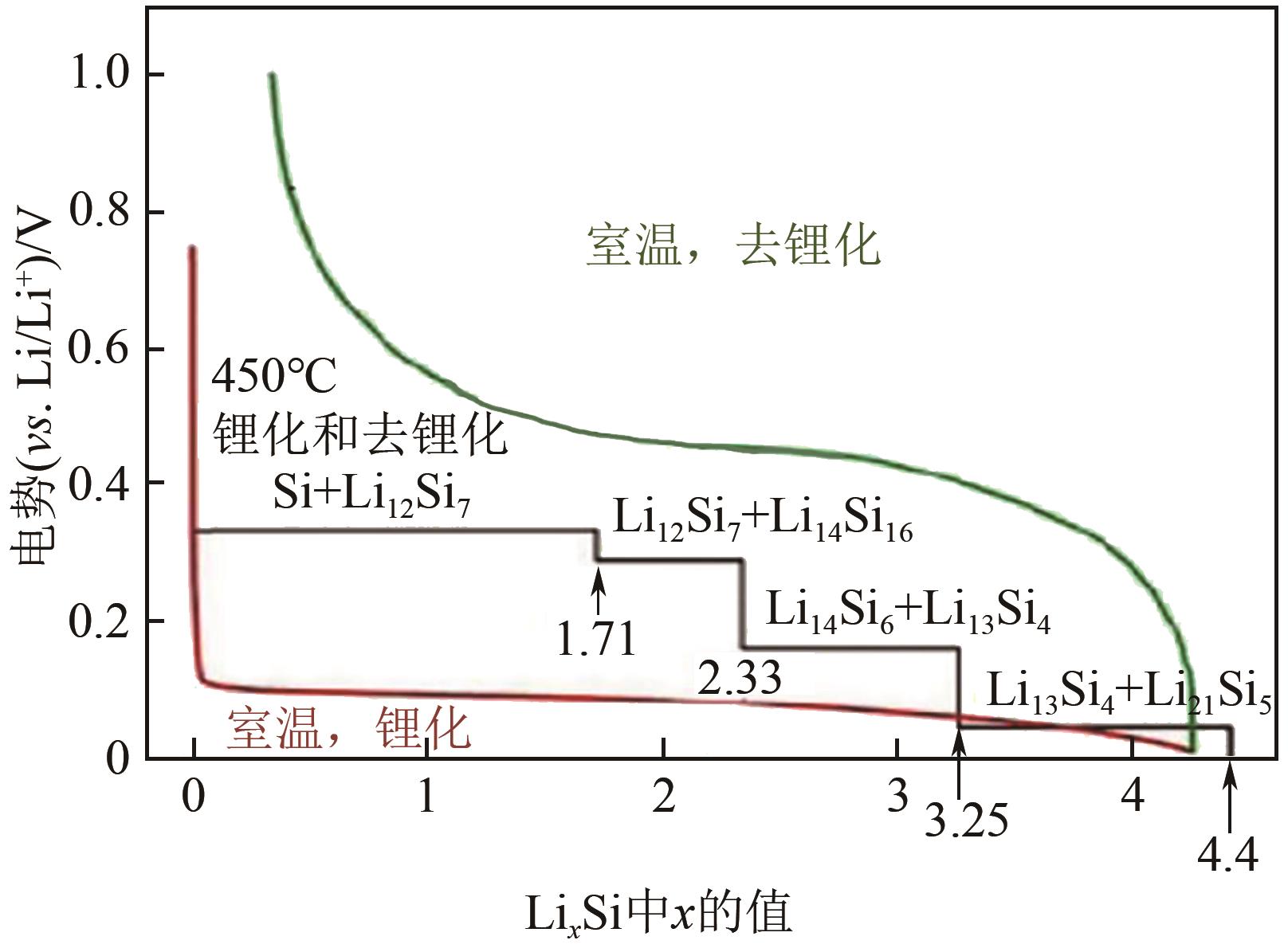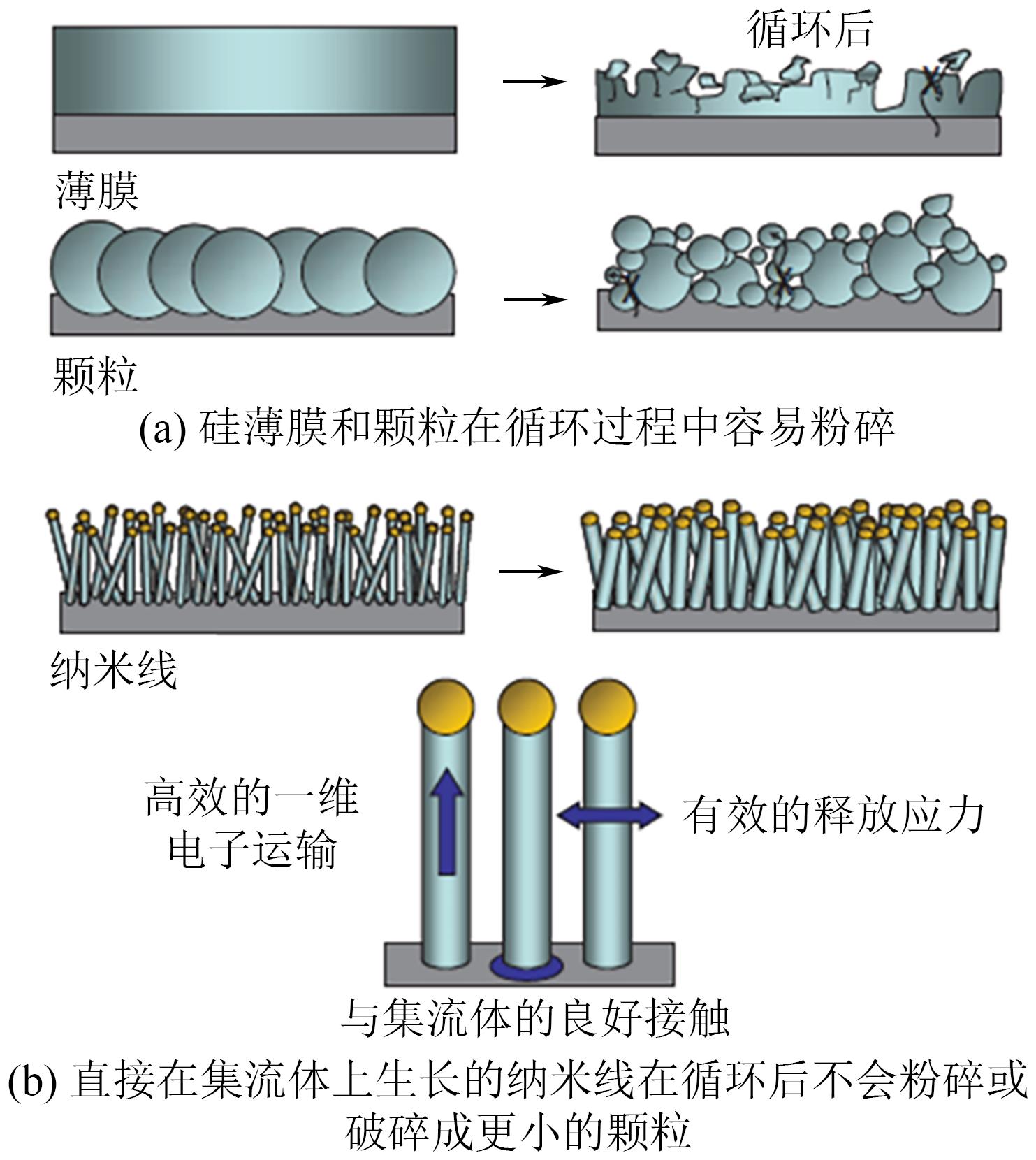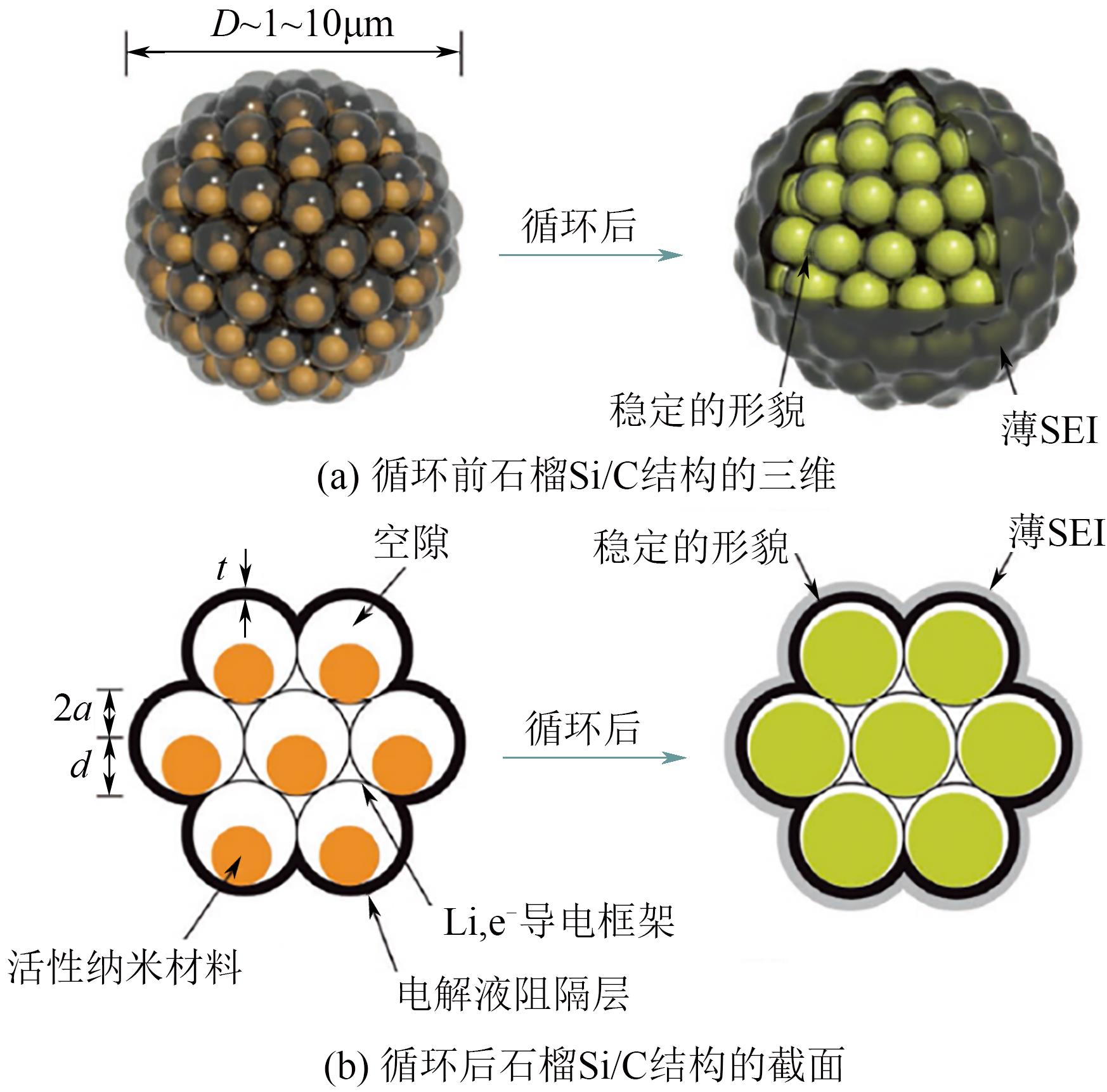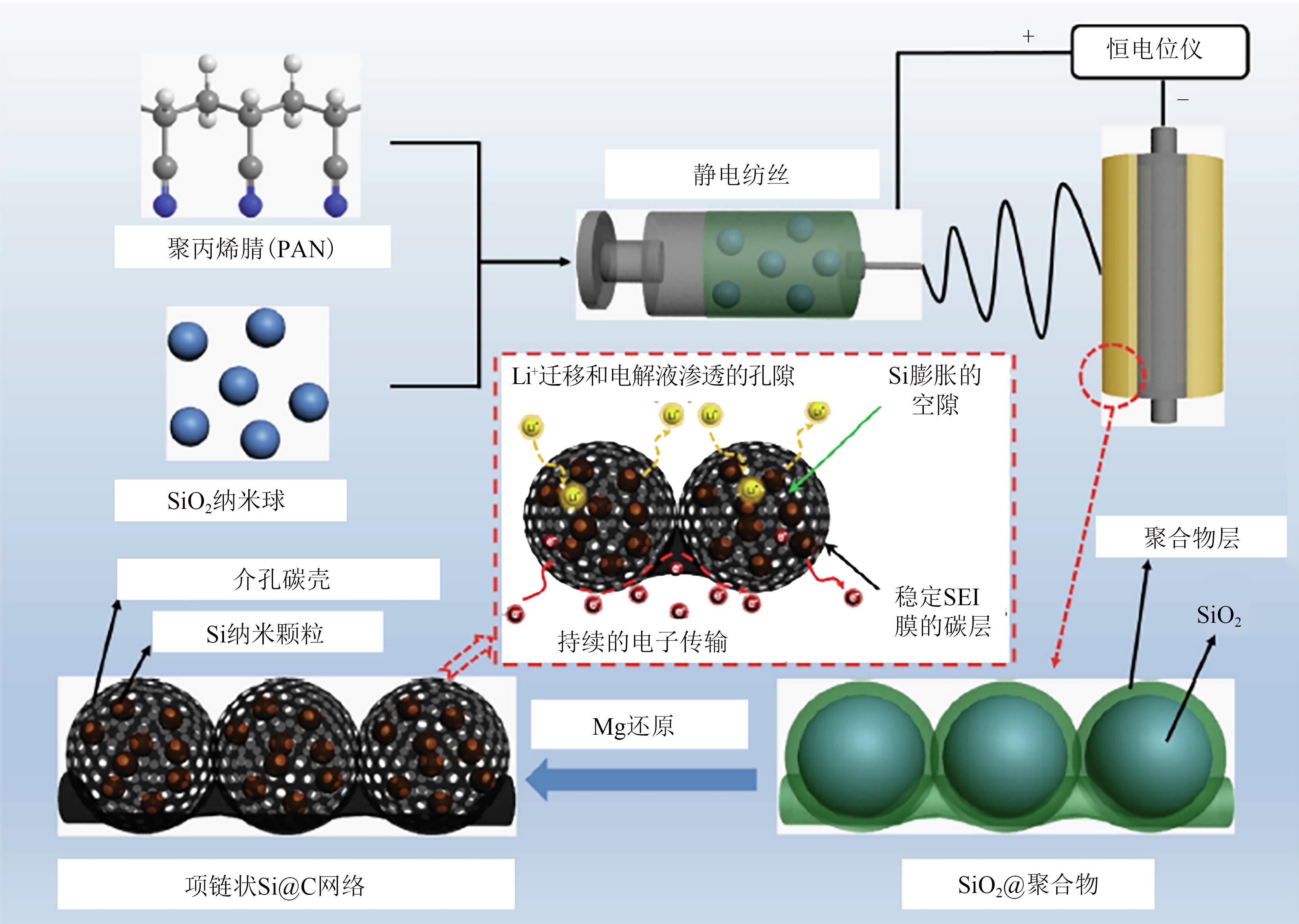化工进展 ›› 2021, Vol. 40 ›› Issue (S1): 253-269.DOI: 10.16085/j.issn.1000-6613.2020-1263
Si基锂离子电池负极材料研究进展
- 大连理工大学材料科学与工程学院,辽宁省能源材料及器件重点实验室,辽宁 大连 116024
-
收稿日期:2020-07-06修回日期:2020-11-11出版日期:2021-10-25发布日期:2021-11-09 -
通讯作者:吴爱民 -
作者简介:邱治文(1991—),男,博士研究生,研究方向为锂离子电池硅负极材料改性。E-mail:qiuzhiwen@mail.dlut.edu.cn 。 -
基金资助:中央高校基本科研业务费重点实验室专项(DUT19LAB29)
Research progress of Si-based anode materials for Li-ion battery
QIU Zhiwen( ), WU Aimin(
), WU Aimin( ), WANG Jie, HUANG Hao
), WANG Jie, HUANG Hao
- Key Laboratory of Materials Modification by Laser, Ion and Electron Beams (Ministry of Education), School of Materials Science and Engineering, Dalian University of Technology, Dalian 116024, Liaoning, China
-
Received:2020-07-06Revised:2020-11-11Online:2021-10-25Published:2021-11-09 -
Contact:WU Aimin
摘要:
硅具有高的理论比容量、较低的嵌锂电位、来源广泛且环境友好等优点,被认为是下一代锂离子电池负极材料的有力竞争者。然而,在锂离子脱嵌过程中巨大的体积膨胀引起了活性材料的粉化和破裂,这带来了电极循环性能差、容量衰减快甚至电极失效等一系列问题。迄今为止,有大量关于改性硅基材料的报道。本文将重点介绍硅基材料的纳米结构化设计和硅/碳材料的结合。首先,分析了硅的储锂及失效机制,从机理上理解硅的失效对其电化学性能的影响。其次,从理论上阐述了纳米级硅材料对缓解体积效应的机理,从结构设计、材料合成、形态特征和电化学性能等方面论证了纳米硅材料的优势。随后,从缓解体积膨胀、提高电导率和形成稳定的固体电解质(SEI)膜等方面总结了硅碳复合材料的研究进展。此外,还讨论了将导电聚合物和金属引入硅基材料的电化学性能增强机理。最后,从提高首次库仑效率、SEI膜稳定性和质量负载量等方面对硅基材料的产业化应用提出几点建议。
中图分类号:
引用本文
邱治文, 吴爱民, 王杰, 黄昊. Si基锂离子电池负极材料研究进展[J]. 化工进展, 2021, 40(S1): 253-269.
QIU Zhiwen, WU Aimin, WANG Jie, HUANG Hao. Research progress of Si-based anode materials for Li-ion battery[J]. Chemical Industry and Engineering Progress, 2021, 40(S1): 253-269.
| 1 | SHEN Xiaohui, TIAN Zhanyuan, FAN Ruijuan, et al. Research progress on silicon/carbon composite anode materials for lithium-ion battery[J]. Journal of Energy Chemistry, 2018, 27(4): 1067-1090. |
| 2 | THACKERAY Michael M, WOLVERTON Christopher, ISAACS Eric D. Electrical energy storage for transportation approaching the limits of, and going beyond, lithium-ion batteries[J]. Energy & Environmental Science, 2012, 5(7): 7854-7863. |
| 3 | XU Xiangyang. Development of transmission technology for energy-saving vehicles and new energy resource vehicle[J]. Journal of Automotive Safety and Energy, 2017(4): 1. |
| 4 | MAZIAR Ashuri, HE Qianran, SHAW Leon L. Silicon as a potential anode material for Li-ion batteries: where size, geometry and structure matter[J]. Nanoscale, 2016, 8(1): 74-103. |
| 5 | CHOI W J, REDDYPRAKASH M, LOKA Chadrasekhar, et al. Carbon coated Si-metal silicide composite anode materials prepared by high-energy milling and carburization for Li-ion rechargeable batteries[J]. Journal of the Electrochemical Society, 2019, 166(3): A5131-A5138. |
| 6 | LIU H K, GUO Z P, WANG J Z, et al. Si-based anode materials for lithium rechargeable batteries[J]. Journal of Materials Chemistry, 2010, 20(45): 10055-10057. |
| 7 | LIU Nian, WU Hui, MCDOWELL Matthew T, et al. A yolk-shell design for stabilized and scalable Li-ion battery alloy anodes[J]. Nano Letters, 2012, 12(6): 3315-3321. |
| 8 | SU Xin, WU Qingliu, LI Juchuan, et al. Silicon-based nanomaterials for lithium-ion batteries: a review[J]. Advanced Energy Materials, 2014, 4(1): 1300882. |
| 9 | LIU Lehao, Jing LYU, LI Tiehu, et al. Well-constructed silicon-based materials as high-performance lithium-ion battery anodes[J]. Nanoscale, 2016, 8(2): 701-722. |
| 10 | WU Hui, CUI Yi. Designing nanostructured Si anodes for high energy lithium ion batteries[J]. Nano Today, 2012, 7(5): 414-429. |
| 11 | LIU Xiaohua, ZHONG Li, HUANG Shan, et al. Size-dependent fracture of silicon nanoparticles during lithiation[J]. ACS Nano, 2012, 6(2): 1522-1531. |
| 12 | WANG Dingsheng, GAO Mingxia, PAN Hongge, et al. High performance amorphous-Si@SiOx/C composite anode materials for Li-ion batteries derived from ball-milling and in situ carbonization[J]. Journal of Power Sources, 2014, 256: 190-199. |
| 13 | TERRANOVA Maria Letizia, ORLANDUCCI Silvia, TAMBURRI Emanuela, et al. Si/C hybrid nanostructures for Li-ion anodes: an overview[J]. Journal of Power Sources, 2014, 246: 167-177. |
| 14 | SAINT Juliette, MORCRETTE Mathieu, LARCHER Dominique, et al. Towards a fundamental understanding of the improved electrochemical performance of silicon-carbon composites[J]. Advanced Functional Materials, 2007, 17(11): 1765-1774. |
| 15 | WANG Chao, LUO Fei, LU Hao, et al. A well-defined silicon nanocone-carbon structure for demonstrating exclusive influences of carbon coating on silicon anode of lithium-ion batteries[J]. ACS Applied Materials & Interfaces, 2017, 9(3): 2806-2814. |
| 16 | HWANG S M, LEE H Y, JANG S W, et al. Lithium insertion in SiAg powders produced by mechanical alloying[J]. Electrochemical and Solid-State Letters, 2001, 4(7): A97-A100. |
| 17 | ROBERTS G A, CAIRNS E J, REIMER J A. Magnesium silicide as a negative electrode material for lithium-ion batteries[J]. Journal of Power Sources, 2002, 110(2): 424-429. |
| 18 | WOLFENSTINE J. CaSi2 as an anode for lithium-ion batteries[J]. Journal of Power Sources, 2003, 124(1): 241-245. |
| 19 | YANG Jianping, WANG Yunxiao, LI Wei, et al. Amorphous TiO2 shells: a vital elastic buffering layer on silicon nanoparticles for high-performance and safe lithium storage[J]. Advanced Materials, 2017, 29(48): 1700523. |
| 20 | TEKI Ranganath, DATTA Moni K, KRISHNAN Rahul, et al. Nanostructured silicon anodes for lithium ion rechargeable batteries[J]. Small, 2010, 5(20):2236-2242. |
| 21 | LIMTHONGKUL P, JANG Y I, DUDNEY N J, et al. Electrochemically-driven solid-state amorphization in lithium-silicon alloys and implications for lithium storage[J]. Acta Materialia, 2003, 51(4): 1103-1113. |
| 22 | LI J, DAHN J R. An in situ X-ray diffraction study of the reaction of Li with crystalline Si[J]. Journal of the Electrochemical Society, 2007, 154(3): A156-A161. |
| 23 | LIU Xiaohua, WANG Jiangwei, HUANG Shan, et al. In situ atomic-scale imaging of electrochemical lithiation in silicon[J]. Nature Nanotechnology, 2012, 7(11): 749-756. |
| 24 | CHAN Maria K Y, WOLVERTON C, GREELEY Jeffrey P. First principles simulations of the electrochemical lithiation and delithiation of faceted crystalline silicon[J]. Journal of the American Chemical Society, 2012, 134(35): 14362-14374. |
| 25 | LEE S W, MVDOWELL M T, CHOI J W, et al. Anomalous shape changes of silicon nanopillars by electrochemical lithiation[J]. Nano Letters, 2011, 11(7): 3034-3039. |
| 26 | KIM S P, DATTA D, SHENOY V B. Atomistic mechanisms of phase boundary evolution during initial lithiation of crystalline silicon[J]. The Journal of Physical Chemistry C, 2014, 118(31): 17247-17253. |
| 27 | JOHARI Priya, QI Yue, SHENOY Vivek B. The mixing mechanism during lithiation of Si negative electrode in Li-ion batteries: an ab initio molecular dynamics study[J]. Nano letters, 2011, 11(12): 5494-5500. |
| 28 | CUBUK Ekin D, KAXIRAS Efthimios. Theory of structural transformation in lithiated amorphous silicon[J]. Nano Letters, 2014, 14(7): 4065-4070. |
| 29 | CHEN Gen, YAN Litao, LUO Hongmei, et al. Nanoscale engineering of heterostructured anode materials for boosting lithium-ion storage[J]. Advanced Materials, 2016, 28(35): 7580-7602. |
| 30 | WOODFORD William Henry, CHIANG Y M, Craig CARTER W. “Electrochemical shock” of intercalation electrodes: a fracture mechanics analysis[J]. Journal of the Electrochemical Society, 2010, 157(10): A1052-A1059. |
| 31 | ZHAO Kejie, PHARR Matt, VLASSAK Joost J, et al. Inelastic hosts as electrodes for high-capacity lithium-ion batteries[J]. Journal of Applied Physics, 2011, 109(1): 016110. |
| 32 | GRAETZ J, AHN C C, YAZAMI R, et al. Highly reversible lithium storage in nanostructured silicon[J]. Electrochemical and Solid-State Letters, 2003, 6(9): A194-A197. |
| 33 | GAUTHIER Magali, MAZOUZI Driss, REYTER David, et al. A low-cost and high-performance ball-milled Si-based negative electrode for high-energy Li-ion batteries[J]. Energy & Environmental Science, 2013, 6(7): 2145-2155. |
| 34 | ZHU Bin, JIN Yan, TAN Yingling, et al. Scalable production of Si nanoparticles directly from low grade sources for lithium-ion battery anode[J]. Nano Letters, 2015, 15(9): 5750-5754. |
| 35 | NGUYEN Hung T, YAO Fei, ZAMFIR Mihai R, et al. Highly interconnected Si nanowires for improved stability Li-ion battery anodes[J]. Advanced Energy Materials, 2011, 1(6): 1154-1161. |
| 36 | LAIK Barbara, EUDE Laurent, Jean-Pierre PEREIRA-RAMOS, et al. Silicon nanowires as negative electrode for lithium-ion microbatteries[J]. Electrochimica Acta, 2008, 53(17): 5528-5532. |
| 37 | ZHOU G W, LI H, SUN H P, et al. Controlled Li doping of Si nanowires by electrochemical insertion method[J]. Applied Physics Letters, 1999, 75(16): 2447-2449. |
| 38 | YU Jieyi, GAO Jian, XUE Fanghong, et al. Formation mechanism and optical characterization of polymorphic silicon nanostructures by DC arc-discharge[J]. RSC Advances, 2015, 5(84): 68714-68721. |
| 39 | LIU Xiaohua, ZHENG He, ZHONG Li, et al. Anisotropic swelling and fracture of silicon nanowires during lithiation[J]. Nano Letters, 2011, 11(8): 3312-3318. |
| 40 | LIU Xiaohua, FAN Feifei, YANG Hui, et al. Self-limiting lithiation in silicon nanowires[J]. Acs Nano, 2013, 7(2): 1495-1503. |
| 41 | MOON Taeho, KIM Chunjoong, PARK Byungwoo. Electrochemical performance of amorphous-silicon thin films for lithium rechargeable batteries[J]. Journal of Power Sources, 2006, 155(2): 391-394. |
| 42 | CHEN L B, XIE J Y, YU H C, et al. Si-Al thin film anode material with superior cycle performance and rate capability for lithium ion batteries[J]. Electrochimica Acta, 2008, 53(28): 8149-8153. |
| 43 | CHEN L B, XIE J Y, YU H C, et al. An amorphous Si thin film anode with high capacity and long cycling life for lithium ion batteries[J]. Journal of Applied Electrochemistry, 2009, 39(8): 1157-1162. |
| 44 | ZHAO Guangyu, MENG Yufeng, ZHANG Naiqing, et al. Electrodeposited Si film with excellent stability and high rate performance for lithium-ion battery anodes[J]. Materials Letters, 2012, 76: 55-58. |
| 45 | LIU Ping, ZHENG Junjun, QIAO Yongmin, et al. Fabrication and characterization of porous Si-Al films anode with different macroporous substrates for lithium-ion batteries[J]. Journal of Solid State Electrochemistry, 2014, 18(7): 1799-1806. |
| 46 | CHIU K F, SU S H, LEU H J, et al. Silicon thin film anodes coated on micron carbon-fiber current collectors for lithium ion batteries[J]. Surface and Coatings Technology, 2015, 267: 70-74. |
| 47 | CUI L F, HU L B, CHOI J W, et al. Light-weight free-standing carbon nanotube-silicon films for anodes of lithium ion batteries[J]. ACS Nano, 2010, 4(7): 3671-3678. |
| 48 | ZHANG Ye, FU Zhengwen, QIN Qizong. Microstructure and Li alloy formation of nano-structured amorphous Si and Si/TiN composite thin film electrodes[J]. Electrochemistry Communications, 2004, 6(5): 484-491. |
| 49 | KIM J B, LEE H Y, LEE K S, et al. Fe/Si multi-layer thin film anodes for lithium rechargeable thin film batteries[J]. Electrochemistry Communications, 2003, 5(7): 544-548. |
| 50 | CHO Jaephil. Porous Si anode materials for lithium rechargeable batteries[J]. Journal of Materials Chemistry, 2010, 20(20): 4009-4014. |
| 51 | LIU Yumin, CHEN Bolei, CAO Feng, et al. One-pot synthesis of three-dimensional silver-embedded porous silicon micronparticles for lithium-ion batteries[J]. Journal of Materials Chemistry, 2011, 21(43): 17083-17086. |
| 52 | BANG B M, KIM H J, SONG H K, et al. Scalable approach to multi-dimensional bulk Si anodes via metal-assisted chemical etching[J]. Energy & Environmental Science, 2011, 4(12): 5013-5019. |
| 53 | BANG B M, LEE J I, KIM H J, et al. High-performance macroporous bulk silicon anodes synthesized by template-free chemical etching[J]. Advanced Energy Materials, 2012, 2(7): 878-883. |
| 54 | JIANG Zhiyu, LI Chunli, HAO Shiji, et al. An easy way for preparing high performance porous silicon powder by acid etching Al—Si alloy powder for lithium ion battery[J]. Electrochimica Acta, 2014, 115: 393-398. |
| 55 | LI Chunli, ZHANG Ping, JIANG Zhiyu. Effect of nano Cu coating on porous Si prepared by acid etching Al-Si alloy powder[J]. Electrochimica Acta, 2015, 161: 408-412. |
| 56 | HOHL A, WIEDER T, VAN A P A, et al. An interface clusters mixture model for the structure of amorphous silicon monoxide (SiO)[J]. Journal of Non-Crystalline Solids, 2003, 320(1/2/3): 255-280. |
| 57 | CHOI I, LEE M J, OH S M, et al. Fading mechanisms of carbon-coated and disproportionated Si/SiOx negative electrode (Si/SiOx/C) in Li-ion secondary batteries: dynamics and component analysis by TEM[J]. Electrochimica Acta, 2012, 85: 369-376. |
| 58 | WANG Junyang, WANG Xuelong, LIU Bonan, et al. Size effect on the growth and pulverization behavior of Si nanodomains in SiO anode[J]. Nano Energy, 2020, 75: 105101. |
| 59 | PARK E, PARK M S, LEE J, et al. A highly resilient mesoporous SiOx lithium storage material engineered by oil-water templating[J]. ChemSusChem, 2015, 8(4): 688-694. |
| 60 | Soojin SIM, Pilgun OH, PARK Soojin, et al. Critical thickness of SiO2 coating layer on core@shell bulk@nanowire Si anode materials for Li-ion batteries[J]. Advanced Materials, 2013, 25(32): 4498-4503. |
| 61 | XU Quan, SUN Jiankun, YIN Yaxia, et al. Facile synthesis of blocky SiOx/C with graphite-like structure for high-performance lithium-ion battery anodes[J]. Advanced Functional Materials, 2018, 28(8):1705235.1-1705235.7. |
| 62 | ZHANG Xinghao, WANG Denghui, QIU Xiongying, et al. Stable high-capacity and high-rate silicon-based lithium battery anodes upon two-dimensional covalent encapsulation[J]. Nature Communications, 2020, 11(1):3826. |
| 63 | ZHANG Yu, GUO Guannan, CHEN Chen, et al. An affordable manufacturing method to boost the initial Coulombic efficiency of disproportionated SiO lithium-ion battery anodes[J]. Journal of Power Sources, 2019, 426:116-123. |
| 64 | HE Wei, TIAN Huajun, XIN Fengxia, et al. Scalable fabrication of micro-sized bulk porous Si from Fe-Si alloy as a high-performance anode for lithium-ion batteries[J]. Journal of Materials Chemistry A, 2015, 3(35): 17956-17962. |
| 65 | SI Q, HANAI K, IMANISHI N, et al. Highly reversible carbon-nano-silicon composite anodes for lithium rechargeable batteries[J]. Journal of Power Sources, 2009, 189(1): 761-765. |
| 66 | Minseong KO, CHAE Sujong, MA Jiyoung, et al. Scalable synthesis of silicon-nanolayer-embedded graphite for high-energy lithium-ion batteries[J]. Nature Energy, 2016, 1(9): 1-8. |
| 67 | LEE Jeong K, SMITH Kurt B, HAYNER Cary M, et al. Silicon nanoparticles-graphene paper composites for Li ion battery anodes[J]. Chemical Communications, 2010, 46(12): 2025-2027. |
| 68 | ZHOU Xiaosi, YIN Yaxia, WAN Lijun, et al. Facile synthesis of silicon nanoparticles inserted into graphene sheets as improved anode materials for lithium-ion batteries[J]. Chemical Communications, 2012, 48(16): 2198-2200. |
| 69 | LUO Jiayan, ZHAO Xin, WU Jinsong, et al. Crumpled graphene-encapsulated Si nanoparticles for lithium ion battery anodes[J]. The Journal of Physical Chemistry Letters, 2012, 3(13): 1824-1829. |
| 70 | YANG Shengnan, LI Guorui, ZHU Qing, et al. Covalent binding of Si nanoparticles to graphene sheets and its influence on lithium storage properties of Si negative electrode[J]. Journal of Materials Chemistry, 2012, 22(8): 3420-3425. |
| 71 | ZHAO Guangyu, ZHANG Li, MENG Yufeng, et al. Decoration of graphene with silicon nanoparticles by covalent immobilization for use as anodes in high stability lithium ion batteries[J]. Journal of Power Sources, 2013, 240: 212-218. |
| 72 | WEN Yang, ZHU Yujie, LANGROCK Alex, et al. Graphene-bonded and encapsulated Si nanoparticles for lithium ion battery anodes[J]. Small, 2013, 9(16): 2810-2816. |
| 73 | ZHOU Xiaosi, YIN Yaxia, WAN Lijun, et al. Self-assembled nanocomposite of silicon nanoparticles encapsulated in graphene through electrostatic attraction for lithium-ion batteries[J]. Advanced Energy Materials, 2012, 2(9): 1086-1090. |
| 74 | ZHAO Xin, HAYNER Cary M, KUNG Mayfair C, et al. In-plane vacancy-enabled high-power Si-graphene composite electrode for lithium-ion batteries[J]. Advanced Energy Materials, 2011, 1(6): 1079-1084. |
| 75 | CHANG Jingbo, HUANG Xingkang, ZHOU Guihua, et al. Multilayered Si nanoparticle/reduced graphene oxide hybrid as a high-performance lithium-ion battery anode[J]. Advanced Materials, 2014, 26(5): 758-764. |
| 76 | LI Bin, YANG Shubin, LI Songmei, et al. From commercial sponge toward 3D graphene-silicon networks for superior lithium storage[J]. Advanced Energy Materials, 2015, 5(15): 1500289. |
| 77 | CHEN Shuangqiang, BAO Peite, HUANG Xiaodan, et al. Hierarchical 3D mesoporous silicon@graphene nanoarchitectures for lithium ion batteries with superior performance[J]. Nano Research, 2014, 7(1): 85-94. |
| 78 | WANG Bin, LI Xianglong, LUO Bin, et al. Approaching the downsizing limit of silicon for surface-controlled lithium storage[J]. Advanced Materials, 2015, 27(9): 1526-1532. |
| 79 | LI Na, JIN Shuaixing, LIAO Qingyu, et al. Encapsulated within graphene shell silicon nanoparticles anchored on vertically aligned graphene trees as lithium ion battery anodes[J]. Nano Energy, 2014, 5: 105-115. |
| 80 | ZHOU Min, LI Xianglong, WANG Bin, et al. High-performance silicon battery anodes enabled by engineering graphene assemblies[J]. Nano Letters, 2015, 15(9): 6222-6228. |
| 81 | DU Feihu, WANG Kaixue, CHEN Jiesheng. Strategies to succeed in improving the lithium-ion storage properties of silicon nanomaterials[J]. Journal of Materials Chemistry A, 2016, 4(1): 32-50. |
| 82 | WANG Wei, KUMTA Prashant N. Nanostructured hybrid silicon/carbon nanotube heterostructures: reversible high-capacity lithium-ion anodes[J]. ACS Nano, 2010, 4(4): 2233-2241. |
| 83 | HERTZBERG Benjamin, ALEXEEV Alexander, YUSHIN Gleb. Deformations in Si—Li anodes upon electrochemical alloying in nano-confined space[J]. Journal of the American Chemical Society, 2010, 132(25): 8548-8549. |
| 84 | YU Wanjing, LIU Chang, HOU Pengxiang, et al. Lithiation of silicon nanoparticles confined in carbon nanotubes[J]. ACS Nano,2015, 9(5): 5063-5071. |
| 85 | LIN Huijuan, WENG Wei, QIU Longbin, et al. Twisted aligned carbon nanotube/silicon composite fiber anode for flexible wire-shaped lithium-ion battery[J]. Advanced Materials, 2014, 26(8): 1217-1222. |
| 86 | XIAO Qizhen, FAN Yu, WANG Xinghui, et al. A multilayer Si/CNT coaxial nanofiber LIB anode with a high areal capacity[J]. Energy & Environmental Science, 2014,7 (2): 655-661. |
| 87 | ZHANG Tao, FU Lijun, GAO Jie, et al. Core-shell Si/C nanocomposite as anode material for lithium ion batteries[J]. Pure and Applied Chemistry, 2006, 78(10): 1889-1896. |
| 88 | NG S H, WANG J Z, WEXLER D, et al. Highly reversible lithium storage in spheroidal carbon-coated silicon nanocomposites as anodes for lithium-ion batteries[J]. Angewandte Chemie International Edition, 2006, 45(41): 6896-6899. |
| 89 | JUNG Yoon Seok, LEE Kyu T, Seung M OH. Si-carbon core-shell composite anode in lithium secondary batteries[J]. Electrochimica Acta, 2007, 52(24): 7061-7067. |
| 90 | HOU Guolin, CHENG Benlin, CAO Yuebin, et al. Scalable synthesis of highly dispersed silicon nanospheres by RF thermal plasma and their use as anode materials for high-performance Li-ion batteries[J]. Journal of Materials Chemistry, 2015, A 3 (35): 18136-18145. |
| 91 | LI Peng, ZHAO Guoqiang, ZHENG Xiaobo, et al. Recent progress on silicon-based anode materials for practical lithium-ion battery applications[J]. Energy Storage Materials, 2018, 15: 422-446. |
| 92 | ZHU Jinhui, YANG Jun, XU Zhixin, et al. Silicon anodes protected by a nitrogen-doped porous carbon shell for high-performance lithium-ion batteries[J]. Nanoscale, 2017, 9 (25): 8871-8878. |
| 93 | LUO Wei, WANG Yunxiao, CHOU Shulei, et al. Critical thickness of phenolic resin-based carbon interfacial layer for improving long cycling stability of silicon nanoparticle anodes[J]. Nano Energy, 2016, 27: 255-264. |
| 94 | LIU Nian, LU Zhenda, ZHAO Jie, et al. A pomegranate-inspired nanoscale design for large-volume-change lithium battery anodes[J]. Nature Nanotechnology, 2014 9 (3): 187. |
| 95 | KONG Xiangzhong, ZHENG Yuchao, WANG Yaping, et al. Necklace-like Si@C nanofibers as robust anode materials for high performance lithium ion batteries[J]. Science Bulletin, 2019, 64 (4): 261-269. |
| 96 | MURUGESAN S, HARRIS J T, KORGEL B A, et al. Copper-coated amorphous silicon particles as an anode material for lithium-ion batteries[J]. Chemistry of Materials, 2012, 24(7):1306-1315. |
| 97 | SONG Huchen, WANG Hongxiang, LIN Zixia, et al. Highly connected silicon-copper alloy mixture nanotubes as high-rate and durable anode materials for lithium-ion batteries[J]. Advanced Functional Materials, 2016, 26(4): 524-531. |
| 98 | HUANG Xingkang, PU Haihui, CHANG Jingbo, et al. Improved cyclic performance of Si anodes for lithium-ion batteries by forming intermetallic interphases between Si nanoparticles and metal microparticles[J]. ACS Applied Materials & Interfaces, 2013, 5(22): 11965-11970. |
| 99 | ZHOU Sa, LIU Xiaohua, WANG Dunwei. Si/TiSi2 heteronanostructures as high-capacity anode material for Li ion batteries[J]. Nano Letters, 2010, 10(3): 860-863. |
| 100 | KENNEDY Tadhg, BEZUIDENHOUT Michael, PANLANIAPPAN Kumaranand, et al. Nanowire heterostructures comprising germanium stems and silicon branches as high-capacity Li-ion anodes with tunable rate capability[J]. ACS Nano, 2015 9(7): 7456-7465. |
| 101 | LOKA C, YU H T, LEE K S, et al. Nanocomposite Si/(NiTi) anode materials synthesized by high-energy mechanical milling for lithium-ion rechargeable batteries[J]. Journal of Power Sources, 2013, 244: 259-265. |
| 102 | HAN Hyoung Kyu, LOKA Chadrasekhar, YANG Yun Mo, et al. High capacity retention Si/silicide nanocomposite anode materials fabricated by high-energy mechanical milling for lithium-ion rechargeable batteries[J]. Journal of Power Sources, 2015, 281: 293-300. |
| 103 | KIM Sang Hyung, LEE Dae Hee, PARK Cheolho, et al. Nanocrystalline silicon embedded in an alloy matrix as an anode material for high energy density lithium-ion batteries[J]. Journal of Power Sources, 2018, 395: 328-335. |
| 104 | USUI Hiroyuki, NOUNO Kazuma, TAKEMOYO Yuya, et al. Influence of mechanical grinding on lithium insertion and extraction properties of iron silicide/silicon composites[J]. Journal of Power Sources, 2014, 268: 848-852. |
| 105 | GUO Z P, ZHAO Z W, LIU H K, et al. Lithium insertion in Si-TiC nanocomposite materials produced by high-energy mechanical milling[J]. Journal of Power Sources, 2005, 146(1/2): 190-194. |
| 106 | CHEW S Y, GUO Z P, WANG J Z, et al. Novel nano-silicon/polypyrrole composites for lithium storage[J]. Electrochemistry Communications, 2007, 9(5): 941-946. |
| 107 | WU Hui, YU Guihua, PAN Lijia, et al. Stable Li-ion battery anodes by in-situ polymerization of conducting hydrogel to conformally coat silicon nanoparticles[J]. Nature Communications, 2013, 4(1): 1-6. |
| 108 | YAO Yan, LIU Man, MCDOWELL Matthew T, et al. Improving the cycling stability of silicon nanowire anodes with conducting polymer coatings[J]. Energy & Environmental Science, 2012 5(7): 7927-7930. |
| 109 | YUE Lu, WANG Suqing, ZHAO Xinyue, et al. Nano-silicon composites using poly(3,4-ethylenedioxythiophene): poly (styrenesulfonate) as elastic polymer matrix and carbon source for lithium-ion battery anode[J]. Journal of Materials Chemistry, 2012, 22(3): 1094-1099. |
| 110 | LIU Borui, SOARES Paulo, CHECKLES Constantine, et al. Three-dimensional hierarchical ternary nanostructures for high-performance Li-ion battery anodes[J]. Nano Letters, 2013, 13(7): 3414-3419. |
| 111 | LIN Hengyi, LI ChengHung, WANG Diyan, et al. Chemical doping of a core-shell silicon nanoparticles@polyaniline nanocomposite for the performance enhancement of a lithium ion battery anode[J]. Nanoscale, 2016, 8(3): 1280-1287. |
| [1] | 马伊, 曹世伟, 王家骏, 林立群, 邢延, 曹腾良, 卢峰, 赵振伦, 张志军. 低共熔溶剂回收废旧锂离子电池正极材料的研究进展[J]. 化工进展, 2023, 42(S1): 219-232. |
| [2] | 陈匡胤, 李蕊兰, 童杨, 沈建华. 质子交换膜燃料电池气体扩散层结构与设计研究进展[J]. 化工进展, 2023, 42(S1): 246-259. |
| [3] | 张明焱, 刘燕, 张雪婷, 刘亚科, 李从举, 张秀玲. 非贵金属双功能催化剂在锌空气电池研究进展[J]. 化工进展, 2023, 42(S1): 276-286. |
| [4] | 胡喜, 王明珊, 李恩智, 黄思鸣, 陈俊臣, 郭秉淑, 于博, 马志远, 李星. 二硫化钨复合材料制备与储钠性能研究进展[J]. 化工进展, 2023, 42(S1): 344-355. |
| [5] | 张杰, 白忠波, 冯宝鑫, 彭肖林, 任伟伟, 张菁丽, 刘二勇. PEG及其复合添加剂对电解铜箔后处理的影响[J]. 化工进展, 2023, 42(S1): 374-381. |
| [6] | 孙玉玉, 蔡鑫磊, 汤吉海, 黄晶晶, 黄益平, 刘杰. 反应精馏合成甲基丙烯酸甲酯工艺优化及节能[J]. 化工进展, 2023, 42(S1): 56-63. |
| [7] | 雷伟, 姜维佳, 王玉高, 和明豪, 申峻. N、S共掺杂煤基碳量子点的电化学氧化法制备及用于Fe3+检测[J]. 化工进展, 2023, 42(9): 4799-4807. |
| [8] | 刘炫麟, 王驿凯, 戴苏洲, 殷勇高. 热泵中氨基甲酸铵分解反应特性及反应器结构优化[J]. 化工进展, 2023, 42(9): 4522-4530. |
| [9] | 王晨, 白浩良, 康雪. 大功率UV-LED散热与纳米TiO2光催化酸性红26耦合系统性能[J]. 化工进展, 2023, 42(9): 4905-4916. |
| [10] | 杨莹, 侯豪杰, 黄瑞, 崔煜, 王兵, 刘健, 鲍卫仁, 常丽萍, 王建成, 韩丽娜. 利用煤焦油中酚类物质Stöber法制备碳纳米球用于CO2吸附[J]. 化工进展, 2023, 42(9): 5011-5018. |
| [11] | 尹新宇, 皮丕辉, 文秀芳, 钱宇. 特殊浸润性材料在防治油气管道中水合物成核与聚集的应用[J]. 化工进展, 2023, 42(8): 4076-4092. |
| [12] | 王耀刚, 韩子姗, 高嘉辰, 王新宇, 李思琪, 杨全红, 翁哲. 铜基催化剂电还原二氧化碳选择性的调控策略[J]. 化工进展, 2023, 42(8): 4043-4057. |
| [13] | 刘毅, 房强, 钟达忠, 赵强, 李晋平. Ag/Cu耦合催化剂的Cu晶面调控用于电催化二氧化碳还原[J]. 化工进展, 2023, 42(8): 4136-4142. |
| [14] | 张亚娟, 徐惠, 胡贝, 史星伟. 化学镀法制备NiCoP/rGO/NF高效电解水析氢催化剂[J]. 化工进展, 2023, 42(8): 4275-4282. |
| [15] | 王帅晴, 杨思文, 李娜, 孙占英, 安浩然. 元素掺杂生物质炭材料在电化学储能中的研究进展[J]. 化工进展, 2023, 42(8): 4296-4306. |
| 阅读次数 | ||||||
|
全文 |
|
|||||
|
摘要 |
|
|||||







